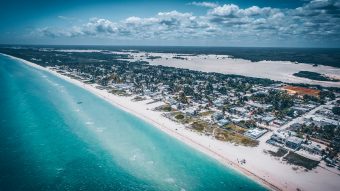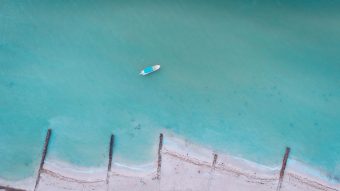
Mexico’s Yucatan Peninsula is home to clear blue seas, golden sands and a glorious backdrop that includes ancient Mayan ruins. Millions flock to its resorts every year and tourism is vital to the area’s economy.
But now much of the coast is covered in heaps of rotting seaweed, contributing to an economic and ecological crisis.
The issue has been caused by an enormous bloom of sargassum algae, which washed ashore from the nearby Sargasso Sea. There has long been sargassum in that part of the ocean. But the rate of its growth has increased rapidly in recent years – so much so that in 2018 its summer bloom almost spanned the Atlantic from West Africa to the Caribbean.
And things are set to get even worse.
The roots of the problem
At around 550 kilometres in length, another mass of sargassum algae is heading towards the Mexican coast. It’s roughly the same size as the island of Jamaica, and when it arrives it could stretch all the way south along the Yucatan Peninsula to Belize.
One of the core causes is deforestation. In addition to contributing to global warming, it also causes soil erosion, which in turn, leads to surplus nutrients being washed into rivers and flowing into the ocean.
Rising nutrient and nitrogen levels have several effects on the seawater. One is to limit the amount of oxygen in the water, creating dead zones, according to the US National Ocean Service. The other is to promote the growth of seaweed and algal blooms – like the Sargasso seaweed that is now swamping Mexican beaches.
Cross-continental causes
Several thousand kilometres to the south of the Yucatan lies the Amazon rainforest, around 17% of which has been lost to deforestation over the past 50 years. Meanwhile, the US Geological Survey points to a worsening situation in West Africa, where more than 80% of the Upper Guinean Forest was lost in the first 75 years of the 20th century and continues to face deforestation.
The huge sargassum algae islands that form out at sea are living entities. They also provide shelter for myriad tiny marine organisms. But once they wash ashore, the algae dies and starts to decompose. Toxic gases are then released into the air, while acid and heavy metals are left behind to make their way into the sea, altering the water’s acidity levels and further depleting oxygen.
The economic fallout

It’s a bleak picture. Beaches ruined by deposits of foul-smelling, rotting seaweed are bad for tourism.
And the effect of the chemicals leaching first into the ground and then into the sea is to poison the offshore waters, resulting in a loss of marine life. It is also contributing to so-called white syndrome, which kills coral tissue.
Mexico’s president, Andrés Manuel López Obrador, estimates the cost of cleaning up the beaches to be around $2.7 million.
But the impact on tourism, which contributes 8.7% to Mexico’s gross domestic product and is worth around $23 billion annually, will be far greater. The government estimates a drop of 30% in some affected areas.
Written by
Sean Fleming, Senior Writer, Formative Content
Source: weforum.org



